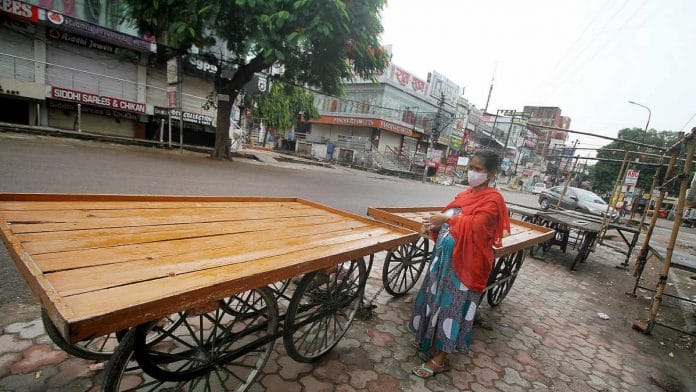The true financial cost of Covid-19 is something India would rather not acknowledge, let alone bear — at least not until the pandemic has played out.
That explains why the central bank on Thursday allowed a one-time restructuring of corporate and personal loans that have been under stress ever since Prime Minister Narendra Modi put the country under a severe lockdown in March.
Those nationwide restrictions have given way to more localized containment. But with India becoming only the third country after the U.S. and Brazil to zoom past the 2 million infections mark, it will be months before the authorities can shift the economy back into its pre-Covid gear.
The engine was sputtering then, too, with consumers retreating from a debt binge, companies deleveraging, exports anemic, real estate in a mess, finance haunted by a mistrust of borrowers, and public works hobbled by low tax resources. Yet just to return to this low-speed economy, India will have to top up the capital destroyed by the coronavirus.
Like almost everywhere else, the ability of assets to earn returns in industries ranging from airlines, hotels and commercial real estate — from large firms to their small vendors — has been impaired. However, in India, truth is currently as scarce as capital. It’s in nobody’s interest to discover the extent of the money shortfall because the hole won’t be filled. The government doesn’t have the appetite for large-scale socialization of private losses, lest the opposition accuse Modi of cronyism. Very few large Indian business groups have dry powder, and those that do — such as billionaire Mukesh Ambani’s Reliance Industries Ltd. — would rather preserve it for now.
Global distressed asset specialists may be willing to take a large bite, but India’s bankruptcy court is shut to new cases for a year. Without the pressure of insolvency, it’s only the property and infrastructure players, whose backs were against the wall even pre-Covid, that may want to sell out to Western private equity and pension funds.
Many borrowers, particularly smaller companies, are currently in the limbo of a central bank moratorium on loan servicing. They will welcome the chance to end this suspended animation with a one-time restructuring. Those plans will be put in place by December and implemented by March, according to the Reserve Bank of India. The lenders, who aren’t even giving an honest picture of delinquent advances, will now use tools like debt-equity swaps and two-year extensions of repayment periods to keep avoiding significant loan-loss provisions.
Most of these hurried recasts will probably follow standardized templates. That’s a worry in a country where even custom-made breathers have tended to fail. But hopefully by the time the arrangements come unstuck, the economy will have stopped shrinking. That way, the banks will have some operating profit to absorb losses. If they were to come clean now, they would have to find much more than the record $10 billion-plus fundraising currently in the works. The capital circle is just too hard to square.
Whether the loan relief succeeds or fails, one thing is certain: India’s $1.4 trillion credit machine will be in stall mode until next March as restructuring “sucks up bankers’ bandwidth,” and the “scope for new credit creation dwindles,” says Nachiket Naik, head of corporate lending at Arka Fincap Ltd., a Mumbai-based financier.
Shadow banks will be the biggest losers. They will restructure their borrowers’ loans but their own liabilities to banks won’t get the same treatment. Only a few years ago, nonbank financiers were meeting 30% of the economy’s new credit demand. But following some bad blowups, starting with the collapse of infrastructure lender IL&FS Group in 2018, the authorities prefer that lending return to deposit-taking banks.
Expect the beaten-down nonbank financiers to become acquisition targets. American buyout firms may be keen, provided they get a good price. It will be an exchange of capital for truth — the two things in short supply in Indian finance. – Bloomberg
Also read: Why economics needs new theories about stimulus and inflation






